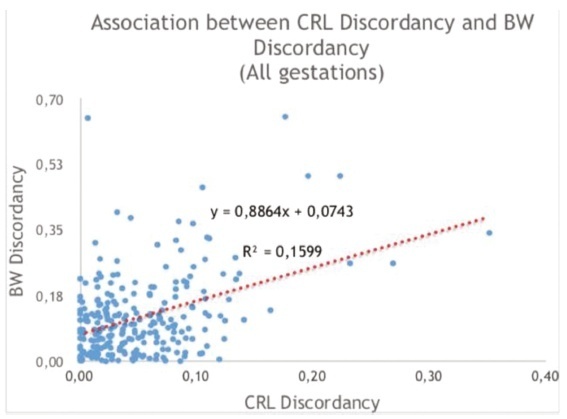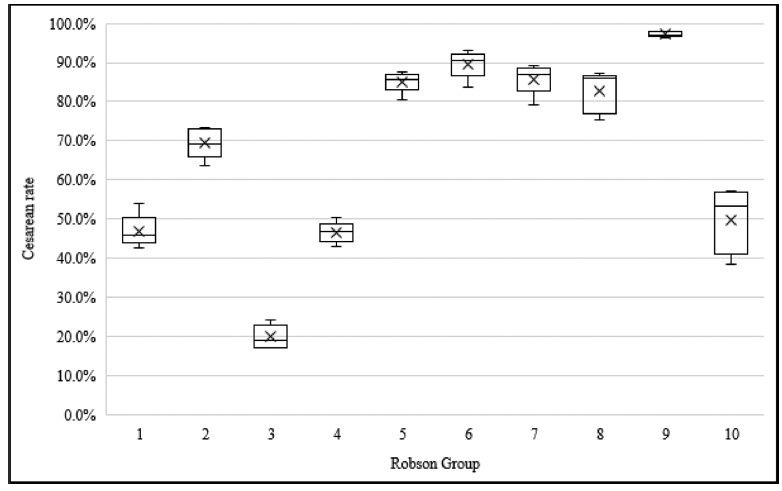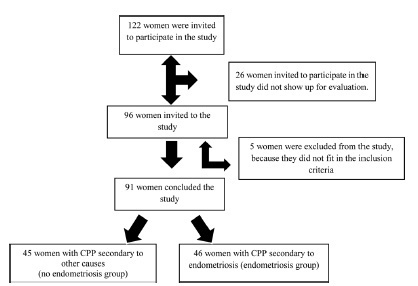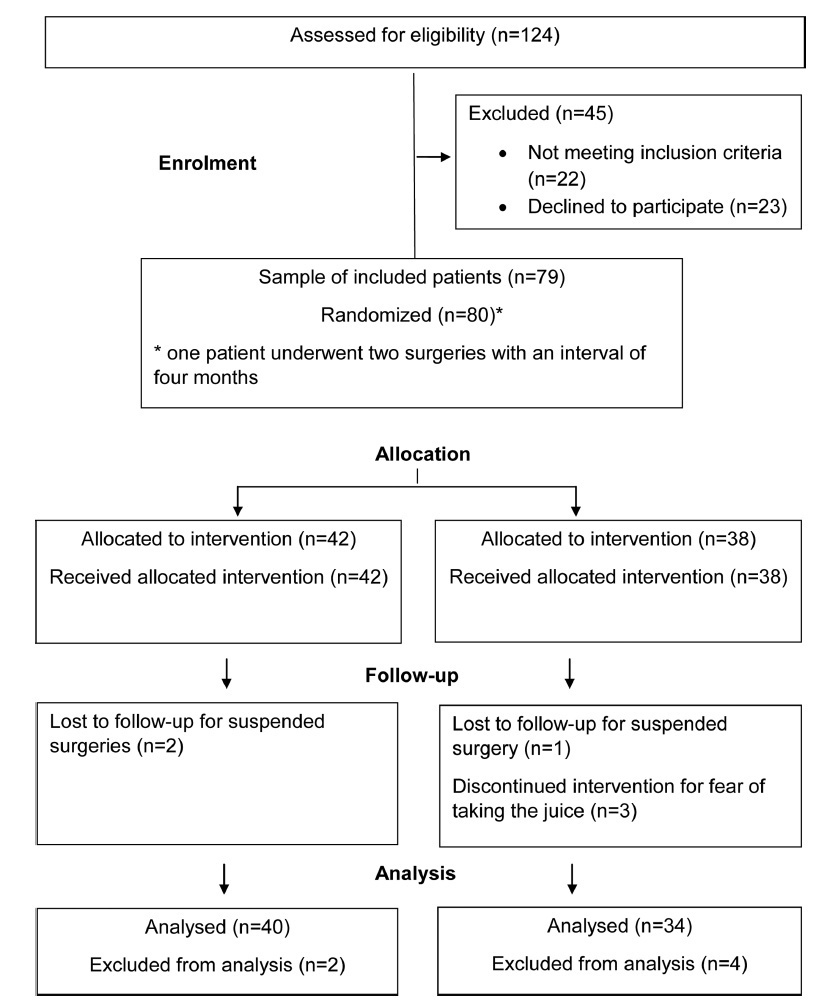Summary
Revista Brasileira de Ginecologia e Obstetrícia. 2020;42(9):540-546
The aim of the present study was to compare the obstetric history and both two- and tri-dimensional ultrasound parameters according to different cervical lengths.
The present cross-sectional study analyzed 248 midtrimester pregnant women according to cervical length and compared the data with the obstetric history and 2D/3D ultrasound parameters. Patients were divided into 3 groups according to cervical length: The Short Cervix group for cervical lengths ≥ 15mm and< 25mm(n= 68), the Very Short Cervix group for cervical lengths< 15mm (n = 18) and the Control group, composed of 162 pregnant women with uterine cervical lengths ≥ 25mm.
When analyzing the obstetric history of only non-nulliparous patients, a significant association between the presence of a short cervix in the current pregnancy and at least one previous preterm birth was reported (p = 0.021). Cervical length and volume were positively correlated (Pearson coefficient = 0.587, p < 0.0001). The flow index (FI) parameter of cervical vascularization was significantly different between the Control and Very Short Cervix groups. However, after linear regression, in the presence of volume information, we found no association between the groups and FI. Uterine artery Doppler was also not related to cervical shortening.
The present study showed a significant association between the presence of a short cervix in the current pregnancy and at least one previous preterm birth. None of the vascularization indexes correlate with cervical length as an independent parameter. Uterine artery Doppler findings do not correlate with cervical length.
Summary
Revista Brasileira de Ginecologia e Obstetrícia. 2020;42(9):535-539
To evaluate the obstetric outcomes of singleton high-risk pregnancies with a small size uterine fibroid.
This retrospective cohort study was conducted among 172 high-risk pregnant women who were followed-up by a single surgeon between 2016 and 2019. Pregnant women with preconceptionally diagnosed small size (< 5 cm) single uterine fibroids (n = 25) were compared with pregnant women without uterine fibroids (n = 147) in terms of obstetric outcomes.
There was no statistically significant difference between the groups in terms of adverse pregnancy outcomes. The size of the fibroids was increased in 60% of the cases, and the growth percentage of the fibroids was 25% during pregnancy. Intrapartum and short-term complication was not observed in women who underwent cesarean myomectomy.
Small size uterine fibroids seem to have no adverse effect on pregnancy outcomes even in high-risk pregnancies, and cesarean myomectomy may be safelyperformed in properly selected cases.
Summary
Revista Brasileira de Ginecologia e Obstetrícia. 2020;42(9):529-534
The purpose of the present study was to analyze the influence of chorionicity in the biometric parameters crown-rump length (CRL), birthweight (BW), crown-rump length discordancy (CRLD) and birthweight discordancy (BWD), determine the correlation between these latter two in cases of intertwin discordancy, and to analyze the influence of chronicity in the presence of these discordancies with clinical relevance (> 10% and > 15%, respectively).
The present study was a retrospective study based on the twin pregnancy database of the Centro Hospitalar S. João (2010-2015), including 486 fetuses among 66 monochorionic (MC) and 177 dichorionic gestations (DC). The inclusion criteria were multiple pregnancies with 2 fetuses and healthy twin gestations. The exclusion criteria were trichorionic gestations and pregnancies with inconclusive chorionicity, multiple pregnancy with ≥ 3 fetuses and pathological twin gestations.
No statistically significant difference was found in BW (p = 0.09) and in its discordancy (p = 0.06) nor in CRL (p = 0.48) and its discordancy (p = 0.74) between MCs and DCs. Crown-rump length discordancy and birthweight discordancy were correlated by the regression line “BWD = 0.8864 x CRLD + 0.0743,” with r2 = 0.1599. Crown-rump length discordancy > 10% was found in 7.58% of monochorionic and in 13.56% of dichorionic twins. Birthweight discordancy > 15% was detected in 16.67% of monochorionic and in 31.64% of dichorionic twins.
No statistically significant influence of chorionicity was identified in both birthweight and birthweight discordancy, as in crown-rump length and crown-rump length discordancy. Birthweight discordancy was correlated to crown-rump length discordancy in 20% of cases.

Summary
Revista Brasileira de Ginecologia e Obstetrícia. 2020;42(9):522-528
To obtain cesarean-section (CS) rates according to the Robson Group Classification in five different regions of Brazil.
A descriptive epidemiological study using data from secondary birth records fromthe Computer Science Department of the Brazilian Unified Health System (Datasus, in Portuguese) between January 1st, 2014, and December 31st, 2016, including all live births in Brazil.
The overall rate of CSwas of 56%. The sample was divided into 11 groups, and vaginal births were more frequent in groups 1 (53.6%), 3 (80.0%) and 4 (55.1%). The highest CS rates were found in groups 5 (85.7%), 6 (89.5%), 7 (85.2%) and 9 (97.0%). The overall CS rate per region varied from 46.2% in the North to 62.1% in the Midwest. Group 5 was the largest obstetric population in the South, Southeast and Midwest, and group 3 was the largest in the North and Northeast. Group 5 contributed the most to the overall CS rate, accounting for 30.8% of CSs.
Over half of the births in Brazil were cesarean sections. The Midwest had the highestCS rates,while theNorth had the lowest. The largestobstetric population in the North and in the Northeast was composed of women in group 3, while in the South, Southeast and Midwest it was group 5. Among all regions, the largest contribution to the overall CS rate was from group 5.

Summary
Revista Brasileira de Ginecologia e Obstetrícia. 2020;42(8):493-500
To examine women with pelvic floor dysfunction (PFDs) and identify factors associated with sexual activity (SA) status that impacts quality of life (QoL).
We conducted a cross-sectional study that includedwomen> 18 years old who presented with at least one PFD symptom (urinary incontinence [UI] and/or pelvic organ prolapse [POP]), in outpatient clinics specializing in urogynecology and PFD in Fortaleza, state of Ceará, Brazil, using a service evaluation form and QoL questionnaires.
The analysis of 659 women with PFD included 286 SA (43.4%) women and 373 non-sexually active (NSA) (56.6%) women, with a mean age of 54.7 (±12) years old. The results revealed that age (odds ratio [OR]= 1.07, 95% confidence interval [CI] 1.03-1.12) and post-menopausal status (OR= 2.28, 95% CI 1.08-4.8) were negatively associated with SA. Being married (OR= 0.43, 95% CI 0.21-0.88) was associated with SA. Pelvic organ prolapse (OR= 1.16, 95% CI 0.81-1.68) and UI (OR= 0.17, 95% CI 0.08-0.36) did not prevent SA. SF-36 Health Survey results indicated that only the domain functional capacity was significantly worse in NSA women (p= 0.012). Two King’s Health Questionnaire domains in NSA women, impact of UI (p= 0.005) and personal relationships (p< 0.001), were significantly associated factors. Data from the Prolapse Quality-of-life Questionnaire indicated that NSA women exhibited compromised QoL.
Postmenopausal status and age negatively affected SA. Being married facilitated SA. Presence of POP and UI did not affect SA. However, NSAwomen with POP exhibited compromised QoL.
Summary
Revista Brasileira de Ginecologia e Obstetrícia. 2020;42(8):486-492
To determine the average body composition (percentage of body fat), the anthropometric markers, and the intensity of clinical pain in women with a clinical diagnosis of chronic pelvic pain (CPP) secondary to endometriosis.
A case-control study performed with 91 women, 46 of whom with CPP secondary to endometriosis and 45 of whom with CPP secondary to other causes. They underwent an evaluation of the anthropometric parameters by means of the body mass index (BMI), the perimeters (waist, abdomen, hip), and the percentage of body fat (%BF), which were assessed on a body composition monitor by bioimpedance; the intensity of the clinical pain was evaluated using the visual analog scale (VAS), and the symptoms of anxiety and depression, using the hospital’s anxiety and depression scale (HAD).
The groups did not differ in terms of mean age, BMI, %BF or regarding the available waist-to-hip ratio (WHR). The mean intensity of the clinical pain by the VAS was of 7.2 ± 2.06 in the group with CPP secondary to endometriosis, and of 5.93 ± 2.64 in the group with CPP secondary to other causes (p = 0.03), revealing significant differences between the groups.
We concluded that, despite the difference in the pain score assessed between the two groups, there was no difference regarding body composition and anthropometry.

Summary
Revista Brasileira de Ginecologia e Obstetrícia. 2020;42(8):476-485
To evaluate the factors associated with complete myomectomy in a single surgical procedure and the aspects related to the early complications.
A cross-sectional study with women with submucous myomas. The dependent variables were the complete myomectomy performed in a single hysteroscopic procedure, and the presence of early complications related to the procedure.
We identified 338 women who underwent hysteroscopic myomectomy. In 89.05% of the cases, there was a single fibroid to be treated. According to the classification of the International Federation of Gynecology and Obstetrics (Fédération Internationale de Gynécologie et d’Obstétrique, FIGO, in French),most fibroids were of grade 0 (66.96%), followed by grade 1 (20.54%), and grade 2 (12.50%). The myomectomies were complete in 63.31% of the cases, and the factors independently associated with complete myomectomy were the diameter of the largest fibroid (prevalence ratio [PR]: 0.97; 95% confidence interval [95%CI]: 0.96-0.98) and the classification 0 of the fibroid according to the FIGO (PR: 2.04; 95%CI: 1.18-3.52). We observed early complications in 13.01% of the hysteroscopic procedures (4.44% presented excessive bleeding during the procedure, 4.14%, uterine perforation, 2.66%, false route, 1.78%, fluid overload, 0.59%, exploratory laparotomy, and 0.3%, postoperative infection). The only independent factor associated with the occurrence of early complications was incomplete myomectomy (PR: 2.77; 95%CI: 1.43-5.38).
Our results show that hysteroscopic myomectomy may result in up to 13% of complications, and the chance of complete resection is greater in small and completely intracavitary fibroids; women with larger fibroids and with a high degree of myometrial penetration have a greater chance of developing complications from hysteroscopic myomectomy.

Summary
Revista Brasileira de Ginecologia e Obstetrícia. 2020;42(8):468-475
To investigate the effects of preoperative fasting abbreviation with a carbohydrate and protein-enriched solution, on postoperative nausea and vomiting (PONV) incidence in gynecological surgery patients, a population naturally at risk for such unpleasant episodes.
The present prospective double-blind randomized study was performed at The Hospital Municipal e Maternidade Dr. Odelmo Leão Carneiro (HMMOLC, in the Portuguese acronym), in Uberlândia, state of Minas Gerais, Brazil, in partnership with the Gynecology Department of the Universidade Federal de São Paulo (UNIFESP), approved by the Human Research EthicsCommittee ofUNIFESP and theboard ofHMMOLC, and included in the Brazil Platform and in the Brazilian Clinical Trial Registry. After signing the consent form, 80 women, who were submitted to gynecological surgery in the period from January to June 2016,were randomized into 2 groups: control group (n= 42) and juice group (n= 38). They received, respectively, 200mL of inert solution or liquid enriched with carbohydrate and protein 4 hours presurgery. The incidence, frequency and intensity of PONV were studied using the Visual Analogue Scale (VAS), with statistical analysis performed by the software IBM SPSS Statistics for Windows, Version 20.0 (IBM Corp, Armonk, NY, USA).
The incidence of nausea and vomiting was lower than in the literature, to this population, with 18.9% (14/74) for the control group and 10.8% (8/74) for the juice group, respectively, with no statistically significant difference between the groups.
The incidence of nausea and vomiting was lower than in the literature, but it cannot be said that this is due to the abbreviation of fasting. It can provide greater comfort, with the possibility of PONV prevention in patients at risk for these episodes.
